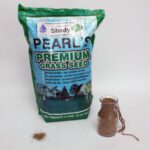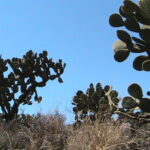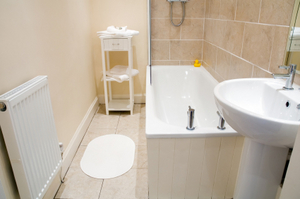Landscaping in the mountains is much different than landscaping in the city. Some landscaping ideas will work in both areas, but not all of them.
I’ve compiled a list of landscaping tips to help anyone in the mountains at high altitude. The best landscaping advice I can give is to do some research by visiting local nurseries and sites online for your area. Ask neighbors and people you meet for landscaping ideas. Landscaping is beautiful and can last a lifetime if it’s done right.
1. Forget the Lawn
Lawns aren’t good for any landscaping purpose. Lawns are high maintenance and use a lot of water. In the mountains, they’re not natural. Visit a local nursery and talk to a professional about the native grasses in your area and landscaping ideas. Native grasses are great for landscaping as they will be acclimated to the high altitude. Some native grasses are beautiful when planted together. Landscaping in the mountains means you can leave your lawnmower behind and go native!
2. Don’t Plant Fruit Tree
We all love flowering apple blossoms or cherry trees; and so do bears and deer! Bears are in most mountain areas, and if you’re landscaping with fruit trees, then you can expect bears. Inviting bears to your yard with fruit trees will make for an inevitable confrontation between you and the bear, or a family member, guest, or a pet. As bears get comfortable around your home, they may also break into your house. With deer, you must keep in mind that a mountain lion’s prime food source is deer. If deer gather in your yard to eat apples, sooner or later a mountain lion will come calling for dinner. If you have pets or small children, they may also become prey.
3. Don’t Use Pesticides
Living in the mountains means living with more wildlife and less people. You need to adapt your landscaping to that fact. Birds, deer, rabbit, bobcats, fox, etc., will visit your landscaped areas when you’re not looking. Don’t use pesticides that will hurt them. They were here first and we are the guests in their living quarters. Use one teaspon of a mild soap such as Ivory or a liquid bath soap to a gallon of water and spray your plants. This will kill the bugs but not the wildlife. Don’t use dish soap as that’s much harsher and may harm your plants.
4. Don’t Use Rocks As Mulch
At high altitude, the sun is brighter and stronger. Landscaping with rocks is popular in the city but not good for plants at high altitude. The sun’s rays will reflect off the rocks to the underside of leaves on plants and can burn them. This happens even in winter. Use mulch, especially cedar mulch for your landscaping. It’s cooler in the mountains so mulch will hold the heat and moisture for your plants.
5. Don’t Plant Plants Too Close Together
This is probably the biggest mistake that most people make when landscaping. Make sure you plant everything at the required spacing that’s listed on the directions. If it says to plant 18 inches apart, then make sure you do that. As the plant matures, it will need those 18 inches to spread out. If you’ve planted something 10 inches near it, then your plants will become cramped, grow and look unhealthy, and you’ll probably have to remove it and replace it with something else. Why waste your time and money? Plant accordingly.
6. Don’t Buy Plants That Won’t Grow in Your Hardiness Zone
Flowering roses, azaleas, and other plants look great in the suburbs. Many of these plants are not good for the mountains because of the high altitude. Visit a local nursery and find out what your Hardiness Zone is. Ask about plants for your Zone, especially native plants. Go online and Google “native plants for ________” plugging in your state. Check out these nurseries online and call them with questions.
7. Don’t Do Anything Until You Know Your Soil
Have your soil checked to see what it’s made up of. A local nursery may have the answers for you, but if not, send your soil out to be analyzed. In the mountains of Colorado, the soil is mostly clay. Purchasing bags of “Claybuster” from Home Depot, or something similar will help break down the clay and make it easier for the survival of your landscaping plants. But don’t add too much Claybuster, as your soil needs to be more on the natural side especially for native plants. For each 100 sq. foot area, I’d suggest adding just 4 or 5 bags of Claybuster.
8. Don’t Plant Too Close to Your Foundation
Landscaping too close to your foundation may cause some problems later on. If your soil is sandy, the sand may gradually wash away from the foundation as you water the plants. If your soil is clay, the clay will hold the water which may cause erosion in the foundation. You don’t want either of these problems. A good rule of thumb is to plant at least 3 ft. away from your foundation. Trees and large shrubs should be planted further away to allow the roots to spread away from the foundation.
9. Don’t Landscape with Shrubs and Plants That Deer and Rabbit will Eat
It would be just awful if you finished your landscaping, and woke up the next morning to find all stubs in your landscaped area. Don’t laugh; I know people that this has happened to! The smell of earth turned over will attract wildlife to that area. You need to do your homework and find out what the native wildlife is and what they like to eat. In most cases, it’s deer and rabbit. I find rabbits much worse than deer in destroying landscaping. A good source that I use is High Country Gardens and their plants are listed as rabbit or deer proof. They’re at www.highcountrygardens.com.
10. Don’t Over-water
Over-watering is a common problem. During the first year, your landscaping will need more water than usual as it adjusts to its new home. After very hot days and/or windy days, your new plants will be thirsty and need water. One way to easily control the water is to install a drip system while you’re landscaping. DIG Irrigation Products is a great do-it-yourself system and can be found at Home Depot.
Source: Personal Experience Living in the Mountains




